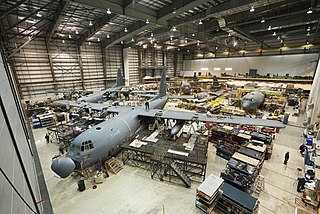
Pratt & Whitney is an American aerospace manufacturer with global service operations. It is a subsidiary of RTX Corporation. Pratt & Whitney's aircraft engines are widely used in both civil aviation and military aviation. Its headquarters are in East Hartford, Connecticut. The company is the world's second largest commercial aircraft engine manufacturer, with a 35% market share as of 2020. In addition to aircraft engines, Pratt & Whitney manufactures gas turbine engines for industrial use, marine propulsion, and power generation. In 2017, the company reported that it supported more than 11,000 customers in 180 countries around the world.

Canadair Ltd. was a Canadian civil and military aircraft manufacturer that operated from 1944 to 1986. In 1986, its assets were acquired by Bombardier Aerospace, the aviation division of Canadian transport conglomerate Bombardier Inc.

The Douglas DC-4 is an American four-engined (piston), propeller-driven airliner developed by the Douglas Aircraft Company. Military versions of the plane, the C-54 and R5D, served during World War II, in the Berlin Airlift and into the 1960s. From 1945, many civil airlines operated the DC-4 worldwide.

The Canadair CT-114 Tutor is a jet trainer that was designed and produced by Canadian aircraft manufacturer Canadair. It served as the standard jet trainer of the Royal Canadian Air Force (RCAF), and later Canadian Armed Forces, between the early 1960s and 2000.

The Pratt & Whitney R-2800 Double Wasp is an American twin-row, 18-cylinder, air-cooled radial aircraft engine with a displacement of 2,800 cu in (46 L), and is part of the long-lived Wasp family of engines.

The de Havilland Canada DHC-2 Beaver is a single-engined high-wing propeller-driven short takeoff and landing (STOL) aircraft developed and manufactured by de Havilland Canada. It has been primarily operated as a bush plane and has been used for a wide variety of utility roles, such as cargo and passenger hauling, aerial application, and civil aviation duties.

Aerial firefighting, also known as waterbombing, is the use of aircraft and other aerial resources to combat wildfires. The types of aircraft used include fixed-wing aircraft and helicopters. Smokejumpers and rappellers are also classified as aerial firefighters, delivered to the fire by parachute from a variety of fixed-wing aircraft, or rappelling from helicopters. Chemicals used to fight fires may include water, water enhancers such as foams and gels, and specially formulated fire retardants such as Phos-Chek.
De Havilland Aircraft of Canada Limited (DHC) is a Canadian aircraft manufacturer that has produced numerous aircraft models since its inception including the popular Dash 8. The company's primary facilities were located in the Downsview area of Toronto, Ontario for many years; in 2022, it was announced that it would relocate primary manufacturing to De Havilland Field, under development near Calgary, Alberta. The aircraft types currently in production or planned for production include the DHC-6 Twin Otter, DHC-8 Dash 8, and DHC-515 Firefighter.

The Canadair CL-415 and the De Havilland Canada DHC-515 are a series of amphibious aircraft built originally by Canadair and subsequently by Bombardier and De Havilland Canada. The CL-415 is based on the Canadair CL-215 and is designed specifically for aerial firefighting; it can perform various other roles, such as search and rescue and utility transport.

Conair Group Inc. of Abbotsford, British Columbia, Canada, formerly known as Conair Aviation, is a company specializing in retrofitting firefighting aircraft, maintaining customer and company-owned aircraft and aerial firefighting. Conair currently employs over 250 staff and has a fleet of aircraft that are broken down into two categories; air attack, and airtankers. Conair specializes in fire management support by providing services and products to forest protection agencies around the world. In 1996 Conair became a Canadian Air Tractor dealer for the AT-802F air tanker. A former Conair Group division; Cascade Aerospace was acquired by the IMP Group of Halifax, Nova Scotia in 2012.
Viking Air Ltd. is an operator and manufacturer of aircraft, as well as aircraft parts and systems, based at Victoria International Airport in North Saanich, British Columbia, Canada. The company provides upgrades to the DHC-2 Beaver, spare parts for older de Havilland Canada aircraft, and components for Bell Helicopter Textron. The company is a subsidiary of De Havilland Canada.

The Orenda PS.13 Iroquois was an advanced turbojet engine designed for military use. It was developed by the Canadian aircraft engine manufacturer Orenda Engines, a part of the Avro Canada group. Intended for the CF-105 Arrow interceptor, development was cancelled, along with the Arrow, in 1959.

The CA-11 Woomera was a production development of the earlier CA-4 Wackett Bomber prototype, and was an Australian torpedo and dive bomber aircraft that was designed and constructed by the Commonwealth Aircraft Corporation (CAC) during World War II. The order for the Woomera was cancelled before it became operational with the Royal Australian Air Force (RAAF).

The Pratt & Whitney JT12, is a small turbojet engine. The Pratt & Whitney T73 is a related turboshaft engine.

The Direction générale de la sécurité civile et de la gestion des crises is a civil defense agency of the French Government. It operates for the Ministry of the Interior and employs some 2,500 civilian and military personnel over 60 sites. Known as the Protection Civile until 1976, the Sécurité Civile is split into several branches:

Cascade Aerospace Inc. of Abbotsford, British Columbia, Canada is a specialty aerospace and defence contractor, focused on providing long-term integrated aircraft support programs for Original Equipment Manufacturers (OEMs), military, government and commercial customers.

Air Spray (1967) Ltd. trading as Air Spray Ltd. of Edmonton, Alberta, Canada and Air Spray USA Inc of Chico, California is a private company specializing in aerial wildfire suppression using air tanker or water bomber aircraft. Air Spray was owned and operated by Canada's Aviation Hall of Fame inductee, Donald T. Hamilton until his death in 2011. The company continued to be owned and operated by his daughter, Lynn Hamilton, of Foothills, Alberta.

The Firecatcher Aircraft F-45 is a single-turboprop aircraft designed for aerial firefighting, air freight and commuter airlines. It is financed by UK start-up Arcus Fire, designed by New Zealand firm Flight Structures and built by NZ's Pacific Aerospace. First flight is planned for 2023 and first delivery for 2024.
Bridger Aerospace is an American aerospace company which provides aerial firefighting and wildfire management services. At the Martin Fire in Nevada in 2018, it was the first private company to legally fly a drone over a wildfire.





























